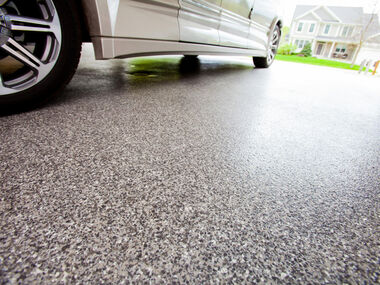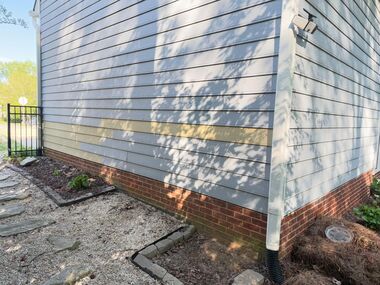Get the Lead Out: How Lead-Certified Contractors Renovate, Repair, and Paint Over Lead Paint

Lead paint is toxic. Protect yourself, your loved ones, or your occupants from this highly toxic metal by letting a lead paint certified contractor remove the threat this type of paint poses from your property today.
What You Should Know About Lead Paint
Lead paint contains large amounts of lead, a highly toxic metal. It was typically used in properties built before 1978.
Lead paint is generally not a problem when it is in good shape. It only becomes a severe health hazard over time when it starts deteriorating. Once the lead paint wears down by rubbing or friction, it will produce microscopic lead dust that could end up on your doors, floors, windows, cabinets, porches, and more. Exposure to these particles could result in irreversible health damage. That is why it is crucial to remove peeling, chalking, chipping, cracking, or damaged lead-based paint from your property immediately.
What Happens When You’re Exposed to Lead
Are you moving into an old house you just recently purchased? Perhaps you’re putting your old property under renovation. Either way, you might be exposed to lead.
Lead can enter your body when you inhale, ingest microscopic lead dust, or eat lead paint chips. The latter may sound ridiculous, but it is often a hazard in young children. When the metal is absorbed into the body, it can damage your vital organs, including your brain, nerves, kidneys, and blood vessels.
Lead poisoning in adults can manifest in various ways. Affected individuals may experience high blood pressure, headache, joint and muscle pain, difficulties with memory or concentration, abdominal pain, and mood disorders.
In addition to serious health conditions, lead exposure can cause learning disabilities, lower intelligence, and even behavioral problems in kids. Even an unborn child can suffer from lead poisoning, because babies exposed to lead before birth might be born prematurely with low birth weight.
Treatments for lead poisoning are available, but they only reduce the blood level of lead. You likely have to live with the health effects of lead exposure. For these reasons, it is crucial to determine any possible lead sources in your property and get rid of them immediately.
Does Your Property Contain Lead-Based Paint?
Given the adverse health effects of lead poisoning, it makes sense to learn whether or not the metal is present in your property. There are several ways that will allow you to detect the presence of lead in the place you’re staying or working.
The Year a House Was Built
One of the simplest ways to know whether your property has lead-based paint is to learn when it was built. More than 80% of residential properties built before 1940 have lead paint. But this type of paint was legal for residential use until 1978, so if your home was built before 1978, err on the side of caution and assume it contains lead paint.
Laboratory Analysis
You can take a paint sample and have it tested by an accredited laboratory. The service does not cost much; it may set you back less than a hundred dollars. When taking the sample, avoid inhaling or ingesting dust or the material. After taking samples, make sure to wash your hands and the tools you use with soap.
Certified Lead-Based Inspector/Assessor
If you want accurate results, hiring a state-certified inspector to inspect your property for lead is your best bet. Ask the inspector for a risk assessment report that will tell you the level of lead present in your home and ways to deal with it.
Lead test kits are also available at most hardware and paint stores. These kits have color-changing chemicals. However, they will only tell you if there is lead in the sample paint and won’t show the amount of lead present on the surface.
If your home has lead paint, the next thing to do is visit your doctor to get a blood lead test. If you have been exposed to the metal, you and your doctor could discuss what to do next to reduce any possible effects of lead poisoning.
Lead Paint Removal: Ensure Your Safety by Hiring Lead-Certified Contractors
Lead paint removal is a hazardous task and shouldn’t be taken on as a DIY project.
Suppose you plan to start renovation, repair, or painting projects that could disturb lead-based paint in a property or house you don’t own. In that case, you must follow the Lead Renovation, Repair, or Painting (RRP) rule developed by the United States Environmental Protection Agency (EPA) and the Department of Housing and Urban Development. The rule requires the use of lead-safe practices.
The rule does not apply to those who own their homes. But for your safety, it is better to hire a lead-certified contractor. A lead-certified contractor knows how to prevent lead exposure when working on properties with lead paint. A contractor acquires a certification after completing the RRP course, which covers lead health effects, regulation, containment, cleaning, record keeping, and lead-safe work practices.
Should You Remove Lead Paint or Paint Over It?
Are you also asking this question: “Is it better to remove lead paint or paint over it?” Well, the answer will depend on the condition of the paint. Here are common ways to deal with lead paint:
Encapsulation
Generally, painting over lead paint is a viable solution. Also called encapsulation, painting over lead-based paint is an effective technique to remediate the paint. It uses epoxy, polymer, or cement-type encapsulation products.
However, encapsulation only works when the lead paint you are trying to cover is still in good condition. It is not ideal if the lead paint is already peeling or in bad shape. The encapsulation paint will only peel or flake off the wall along with the lead-based paint, exposing you to the toxic metal. Painting over the lead paint will also not work if the surface is rubbed, badly deteriorated, or walked on.
Encapsulation only lasts for ten years at most, so you must constantly monitor the encapsulated area to ensure it does not peel.
Lead Paint Removal
You can choose to remove lead paint, no matter its condition. It may be more expensive than encapsulation, but this option will give you peace of mind. After lead paint removal, you’ll have one less safety risk to think about.
Enclosure Method
The enclosure method does not use any paint. As the name suggests, this method covers the old surface with a new one. For example, you cover your window sills with vinyl cladding.
Like encapsulation, it also has drawbacks. If you remove the enclosed surface, you’ll be completely exposed to the lead-based paint underneath. If the paint is still in excellent condition, you can choose not to do anything about it. But since it will surely peel off over time, it’s probably better to deal with it now if you have the means.
Takeaway
The health effects of lead poisoning are irreversible. So, make sure to get this toxic metal out of your property. Hire a lead-based certified contractor, whether you’re planning to renovate or repaint your property.
Anderson Painting: Your Trusted Lead Paint Removal Professionals in North Carolina
Are you searching for lead-certified contractors near you? Whether you want to paint over or remove the existing lead paint, you can count on Anderson Painting to do the job safely and correctly. In addition to painting, our team can also handle carpentry work. Work with a team like ours who can repair your walls and “do it all.” Call Anderson Painting today at (919)-610-1855.




